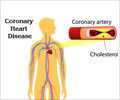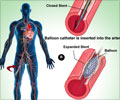Nearly 7 million patients suffering from chronic angina report limitations of their work and other activities two to three times more frequently
Nearly 7 million patients suffering from chronic angina report limitations of their work and other activities two to three times more frequently than the general population. Also, 26 percent of patients still experience angina attacks despite current treatments, such as myocardial revascularization -- a surgery that helps restore blood flow to the heart and is done largely to prevent angina -- and antianginal drugs.
A new treatment may reduce the frequency of angina attacks and help chronic chest pains sufferers exercise longer, according to new research. Researchers say when the drug ranolazine is taken with other antianginal medications, it improves the total exercise time of patients with symptoms of chronic angina.Ranolazine is currently under review by the FDA. For this study, more than 800 patients with symptomatic chronic angina were randomly assigned to receive a placebo or one or two doses of ranolazine. Patients received either placebos twice a day or 750 mg or 1000 mg of ranolazine. Then, they were monitored as they exercised on a treadmill 12 hours after receiving the medication (when it was at the lowest levels in the bloodstream) and four hours after receiving it (when there were the highest levels of the drug in the bloodstream).
Researchers found that when added to a standard dose of frequently prescribed antianginal drugs, ranolazine can reduce both the angina frequency and nitroglycerin consumption. When compared to the placebo results, the decrease in angina attacks were slightly less than one per week for those in the 750 mg group and somewhat more than one per week in the 1,000 mg group. They also found exercise duration increased by nearly two minutes for those in the ranolazine therapy group compared with 90 seconds for those taking placebos. Specialists say, the availability of another effective and apparently safe antianginal medication is “particularly important” for angina patients who are not candidates for revascularization.









